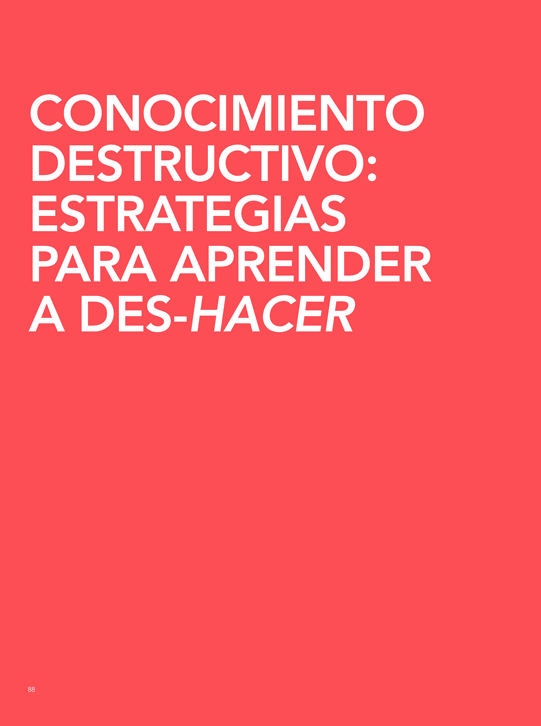Conocimiento destructivo: estrategias para aprender a des-hacer
Barra lateral del artículo

Palabras clave:
Contenido principal del artículo
Resumen
Los arquitectos se mueven por medio de una inercia genealógica que los impulsa a hacer. Se cree que sus herramientas son el medio de imaginar, diseñar, construir y, finalmente, hacer. El do, del latín, sirve como la raíz de una serie de palabras que están relacionadas con la noción del conocimiento acumulado, doctus, doctor, pero también docilis, ser dócil. Gordon Matta-Clark, el conocido artista que se formó como arquitecto, siguió trabajando esencialmente con las herramientas de la arquitectura, pero, en lugar de hacer, la mayor parte de su trabajo está dedicada a deshacer. Sus estrategias no son sólo sobre des-construir edificios, sino que son, mayormente, un modo de búsqueda y exposición de sus impresiones archivadas de arte y arquitectura. Este texto considera la consecuencia conceptual de este proceso de trabajo del artista como una herramienta para interrogar el momento formativo del arte y la arquitectura desarrollando herramientas para des-hacer, es decir, para remover la docilidad del conocimiento disciplinar.
Abstract
Architects are moved by a genealogical inertia that drives them towards doing. Their tools are thought to be the means to imagine, to design, to construct, in the end, to do. The Latin do, serves as the root to a series of words that are related to the notion of accumulated knowledge, doctus, doctor, but also to docilis, to be docile. Gordon Matta-Clark, the well-known artist taught as architect essentially kept working with the tools of architecture, but instead of doing, most of his work is dedicated to undo. His strategies are not only about un-constructing buildings, however, I would argue, they were mostly a mode of search and exposition of his archival impressions of art and architecture. This text considers the conceptual consequence of this working process of the artist as a tool for interrogating the formative moment of art and architecture by developing tools to un-do, this is, to remove docility from disciplinary knowledge.
Detalles del artículo
Materia Arquitectura proporciona acceso inmediato y gratuito a todos los contenidos de esta edición electrónica, publicada simultáneamente con la edición impresa. Materia Arquitectura no cobra honorarios a los autores por ningún concepto.
Todos los contenidos de esta edición electrónica se distribuyen bajo licencia Creative Commons de “Atribución-Copartirigual 4.0 Internacional” (CC-BY-SA).
La licencia Creative Commons permite el acceso libre e inmediato al contenido y permite que cualquier usuario lea, descargue, copie, distribuya, imprima, busque o genere enlaces a los textos completos de los artículos, permitiendo también que estos puedan ser rastreados para indexarlos, pasarlos como datos a software o usarlos para cualquier otro propósito legal. Asimismo, la licencia otorga derechos de uso a quienes a su vez utilicen una licencia abierta (Creative Commons o equivalente).
Los derechos de los textos y las imágenes publicadas pertenecen a sus autores, quienes otorgan a Materia Arquitectura la licencia para su uso. La gestión de los permisos y la autorización de publicación de las imágenes (o de cualquier material) que contenga derechos de autor y sus consecuentes derechos de reproducción en esta publicación es de exclusiva responsabilidad de los autores de los artículos.
Toda vez que mencionen su origen, los autores son libres de distribuir sus artículos por otros medios. Cualquier reproducción total o parcial del material deberá citar su procedencia.
Descargas
Citas
217). Londres, Inglaterra: Phaidon Press.
DERRIDA, J. (1995). Archive Fever: A Freudian Impression. (E. Prenowitz, Trad.) Chicago, IL, EE.UU.: University of Chicago Press.
FOUCAULT, M. (1970). The Order of Things: An Archaeology of the Human Sciences. (A. M. Sheridan Smith, Trad.) Nueva York, NY, EE.UU.: Vintage Books.
LEE, P. M. (2000). Object to be Destroyed: The Work of Gordon Matta-Clark. Cambridge, MA, EE.UU.: The MIT Press.
MCLUHAN, M. (1994). Understanding Media: The Extensions of Man. Cambridge, MA, EE.UU.: MIT Press.
MOURE, G. (Ed.). (2006). Gordon Matta-Clark: Works and Collected Writings. Barcelona, España: Polígrafa.
NIETZSCHE, F. (1986). Human, All Too Human. (R. Hollingdale, Trad.) Cambridge, Inglaterra: Cambridge University Press.
PAPAPETROS, S. (2007). Oedipal and Edible: Roberto Matta Echaurren and Gordon Matta-Clark. En E. Sussman (Ed.), Gordon Matta Clark: You Are The Measure
(págs. 70–82). New Haven, CT, EE.UU.: Yale University Press.
VIDLER, A. (2006). ‘Architecture-To-Be’: Notes On Architecture in The Work of Matta and Matta-Clark. En M. Piranio (Ed.), Transmission: The Art of Matta
and Gordon Matta-Clark (págs. 59–73). San Diego, CA, EE.UU.: San Diego Museum of Art.
WIGLEY, Mark (1993). The Architecture of Deconstruction: Derrida’s Haunt. Cambridge, MA, EE.UU.: The MIT Press.
Artículos más leídos del mismo autor/a
- Marcelo López-Dinardi, Destructive Knowledge: Strategies for Learning to Un-Do , Materia Arquitectura: Núm. 14 (2016): Materia Arquitectura 14 (Diciembre/December 2016)